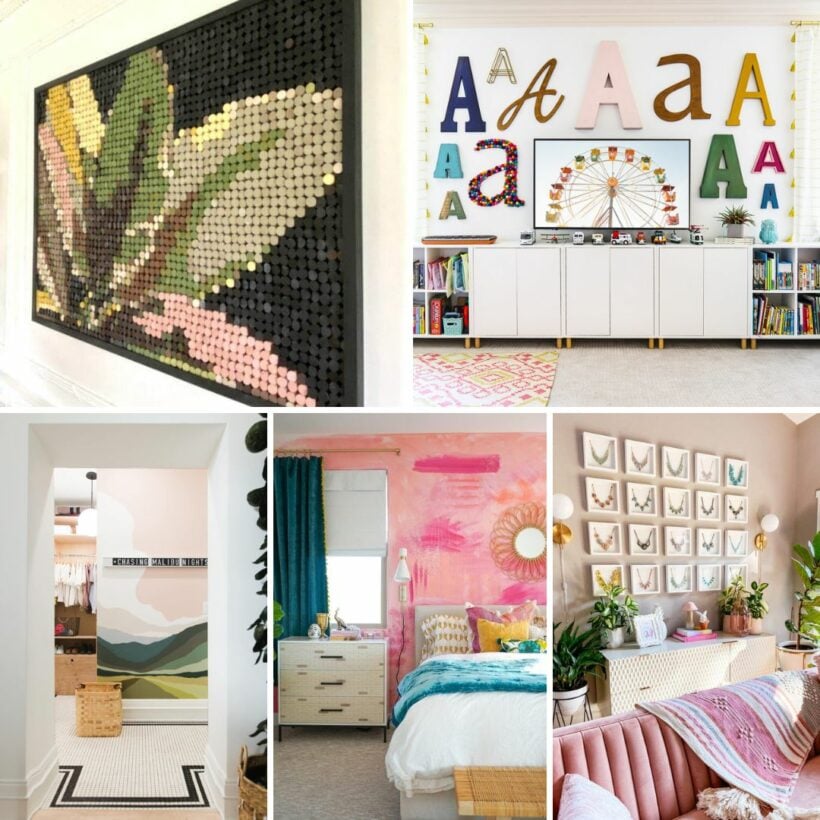DIY decor is more than just a trend; it’s a passion that allows you to personalize your space and reflect your unique style. Whether you’re a seasoned crafter or a curious beginner, the world of DIY decor offers endless possibilities to bring your vision to life. From repurposing old furniture to creating stunning wall art, the joy of DIY decor lies in the process of transforming your surroundings into a reflection of your personality.
This guide will equip you with the knowledge and inspiration to embark on your own DIY decor journey. We’ll explore essential tools and techniques, delve into budget-friendly ideas, and uncover the latest trends that are shaping the world of DIY decor. Get ready to unleash your creativity and create a space that truly feels like home.
DIY Decor Essentials
Embarking on a DIY decor journey requires a well-stocked toolkit and a selection of essential materials. This list provides a comprehensive overview of the key tools and materials needed for various DIY decor projects, from painting and woodworking to fabric crafts and more.
Painting Essentials
Painting is a versatile DIY decor technique that can transform any space. Here are some essential tools and materials for successful painting projects:
- Paintbrushes: Choose a variety of brush sizes for different applications. For large areas, opt for a roller brush.
- Paint Rollers: These are essential for covering large areas quickly and efficiently. Select a roller with a nap length appropriate for the surface being painted.
- Paint Trays: Use a paint tray with a liner to prevent spills and make pouring paint easier.
- Drop Cloths: Protect your floors and furniture from paint splatters.
- Painter’s Tape: Use painter’s tape to create clean lines and protect areas you don’t want to paint.
- Paint Stir Stick: Stir paint thoroughly before and during application to ensure even color and consistency.
- Paint Thinner: Use paint thinner to clean brushes and rollers after use.
- Paint Remover: If you need to remove old paint, a paint remover can be helpful.
Woodworking Essentials
Woodworking projects can add a touch of rustic charm or modern elegance to your decor. Here are some essential tools and materials for woodworking projects:
- Saw: A handsaw or circular saw is essential for cutting wood.
- Hammer: Use a hammer for driving nails and securing pieces of wood.
- Screwdriver: Choose a screwdriver with a variety of bits for different screw sizes.
- Sandpaper: Sandpaper is used to smooth out rough edges and prepare surfaces for painting or staining.
- Wood Glue: Wood glue is used to bond pieces of wood together.
- Wood Stain: Wood stain can be used to enhance the natural color of wood or create a darker, richer finish.
- Wood Filler: Wood filler can be used to fill in holes and cracks in wood.
- Clamps: Clamps are used to hold pieces of wood together while they are being glued or screwed.
Fabric Craft Essentials
Fabric crafts allow you to add pops of color, texture, and personality to your decor. Here are some essential tools and materials for fabric crafts:
- Fabric Scissors: Use sharp fabric scissors for precise cuts.
- Sewing Machine: A sewing machine is essential for creating durable and professional-looking fabric crafts.
- Sewing Needles: Hand sewing needles are useful for smaller projects or for finishing touches.
- Thread: Choose a thread that matches the color of your fabric.
- Fabric: Select fabrics that are appropriate for your project and your desired aesthetic.
- Pins: Use pins to hold fabric pieces in place before sewing.
- Measuring Tape: A measuring tape is essential for accurate fabric measurements.
- Iron: An iron is used to press seams and remove wrinkles from fabric.
Other DIY Decor Essentials
Beyond painting, woodworking, and fabric crafts, there are other essential tools and materials for DIY decor projects. These include:
- Hot Glue Gun: A hot glue gun is a versatile tool for bonding a variety of materials.
- Adhesive: Choose a strong adhesive that is appropriate for the materials you are bonding.
- Scissors: General-purpose scissors are essential for cutting paper, cardboard, and other materials.
- Utility Knife: A utility knife is useful for cutting through thick materials.
- Measuring Tape: A measuring tape is essential for taking accurate measurements for your projects.
- Ruler: A ruler is useful for measuring smaller items and for drawing straight lines.
- Pencil: Use a pencil to mark cutting lines and make plans for your projects.
- Marker: Markers are useful for labeling and outlining.
Tips for Selecting Quality Tools and Materials
When choosing tools and materials for your DIY decor projects, consider the following tips:
- Read reviews: Before purchasing any tools or materials, read reviews from other users to get an idea of their quality and performance.
- Consider your budget: DIY decor projects can range in cost. Set a budget before you start shopping to ensure you stay within your financial limits.
- Choose durable materials: Choose materials that are durable and will withstand the wear and tear of everyday use.
- Think about safety: When using power tools, always wear safety goggles and protective clothing.
DIY Decor Techniques

Transforming your living space into a haven of style and personality doesn’t require professional help. With a little creativity and some DIY decor techniques, you can achieve stunning results without breaking the bank.
Painting
Painting is a versatile and affordable way to refresh your walls, furniture, and accessories. A fresh coat of paint can instantly transform a room’s ambiance.
Here are some steps to follow:
* Prepare the surface: Clean the surface thoroughly to remove dust, dirt, and grease. If necessary, sand the surface to create a smooth finish.
* Apply primer: Primer helps the paint adhere better and creates a more even finish.
* Choose the right paint: Consider the type of surface you are painting, the desired finish, and the level of durability required.
* Apply the paint: Use a brush, roller, or spray gun to apply the paint evenly. Follow the manufacturer’s instructions for drying time and multiple coats.
* Finish with a clear coat: A clear coat protects the paint and adds a glossy or matte finish.
Tip: When painting furniture, consider using painter’s tape to protect surrounding areas. Apply paint in thin coats to prevent drips and ensure even coverage.
Wallpapering
Wallpapering adds a touch of elegance and pattern to your walls. With various styles and designs available, you can create a unique and personalized look.
Follow these steps to achieve a successful wallpapering project:
* Prepare the walls: Ensure the walls are clean, smooth, and free of imperfections.
* Measure and cut the wallpaper: Carefully measure the wall area and cut the wallpaper panels to the appropriate size.
* Apply adhesive: Apply the wallpaper adhesive to the back of the wallpaper panel according to the manufacturer’s instructions.
* Hang the wallpaper: Align the first panel carefully and smooth it onto the wall, working from the center outward.
* Trim and finish: Use a utility knife to trim excess wallpaper and ensure a clean finish.
Tip: When hanging wallpaper, it’s essential to match the patterns and seams carefully for a seamless look. Consider using a level to ensure straight lines and a professional finish.
Stenciling
Stenciling allows you to create intricate designs and patterns on walls, furniture, and fabric. With a stencil, you can achieve a personalized look with minimal effort.
Here’s a guide to stenciling:
* Choose a stencil: Select a stencil that complements your decor style and matches the desired size and design.
* Prepare the surface: Clean and prepare the surface as you would for painting.
* Secure the stencil: Use painter’s tape to secure the stencil firmly in place.
* Apply the paint: Use a brush or sponge to apply the paint evenly within the stencil’s openings.
* Remove the stencil: Carefully remove the stencil after the paint has dried to reveal the design.
Tip: For a crisp and clean stencil design, use a small amount of paint and avoid over-applying it. Consider using a stencil brush specifically designed for this purpose.
Upcycling, Diy decor
Upcycling involves transforming old or discarded items into new and functional pieces. It’s an eco-friendly and cost-effective way to create unique decor.
Here are some common upcycling techniques:
* Repurposing furniture: Give old furniture a new life by painting, sanding, or adding new hardware.
* Reusing materials: Transform old jars, bottles, and other materials into decorative containers, planters, or storage solutions.
* Creating art from scraps: Utilize fabric scraps, paper, and other discarded materials to create unique wall art or decorative pieces.
Tip: Upcycling allows you to unleash your creativity and give a new purpose to items that might otherwise be thrown away. Don’t be afraid to experiment and try different techniques.
DIY Decor Inspiration
Finding inspiration for your next DIY decor project can be a fun and exciting process. It’s all about exploring various sources, letting your creativity flow, and discovering ideas that resonate with your personal style. Let’s delve into some inspiring sources that can spark your imagination.
Blogs and Websites
Blogs and websites offer a vast treasure trove of DIY decor inspiration. They often feature step-by-step tutorials, project ideas, and before-and-after transformations. Many blogs and websites cater to specific decor styles, such as farmhouse, minimalist, or bohemian, allowing you to find inspiration that aligns with your preferences.
- “The Spruce” provides comprehensive DIY guides, covering a wide range of decor projects, from simple crafts to ambitious renovations. They offer detailed instructions, helpful tips, and inspirational photos.
- “Apartment Therapy” features a diverse collection of DIY decor projects, focusing on practical and stylish solutions for small spaces. Their website is a great resource for finding creative ways to maximize space and personalize your home.
- “DIY Network” offers a wealth of DIY project ideas, covering everything from furniture restoration to home improvement. Their website includes video tutorials, expert advice, and a wide range of project inspiration.
Social Media Platforms
Social media platforms like Pinterest, Instagram, and TikTok have become hubs for DIY decor inspiration. These platforms are filled with visually appealing content, from stunning transformations to creative upcycling projects. You can follow specific accounts, search for hashtags, and explore trending DIY decor ideas.
- Pinterest is a visual search engine that allows you to browse millions of images and ideas. You can create boards to organize your inspiration and find projects that align with your aesthetic.
- Instagram is a popular platform for sharing photos and videos. You can follow accounts that specialize in DIY decor, such as home improvement bloggers, crafters, and furniture restorers.
- TikTok is a short-form video platform where users share creative content. You can find countless DIY decor videos, from quick and easy projects to more elaborate transformations.
Magazines
While online resources are abundant, traditional magazines continue to be a source of inspiration for DIY decor. Magazines often feature beautiful photography, design trends, and project ideas that can spark your imagination.
- “Better Homes & Gardens” offers a wide range of DIY decor ideas, from home improvement projects to simple crafts. Their magazine features practical tips, design inspiration, and step-by-step tutorials.
- “House Beautiful” is known for its elegant and stylish home decor ideas. Their magazine features high-quality photography, design trends, and inspiration for creating a beautiful and inviting home.
- “Martha Stewart Living” is a classic source for DIY decor inspiration. Their magazine offers a wide range of projects, from crafting and gardening to home improvement and entertaining.
Final Wrap-Up
As you embark on your DIY decor adventures, remember that the process is just as important as the outcome. Embrace the challenges, celebrate the successes, and most importantly, have fun! Whether you’re adding a personal touch to your living room, creating a cozy bedroom haven, or transforming your kitchen into a culinary masterpiece, DIY decor empowers you to create a space that reflects your individuality and inspires you every day.
DIY decor is a great way to personalize your space and save money. If you’re looking for inspiration, check out the ikea hack community. You’ll find tons of creative ideas for transforming basic IKEA furniture into unique and stylish pieces.
With a little imagination and some DIY skills, you can create a truly one-of-a-kind look for your home.




